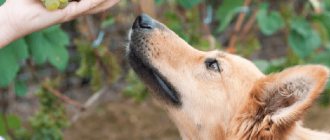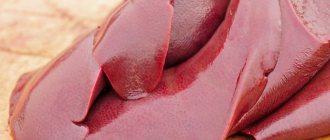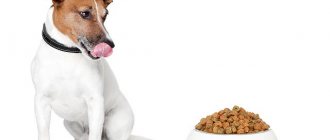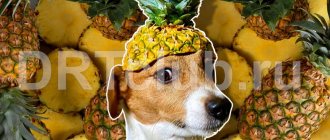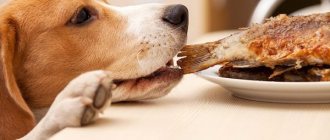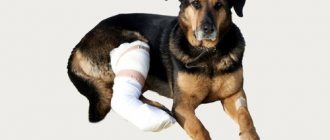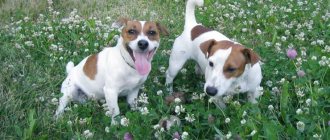The health of pets largely depends on a balanced diet. Many owners are faced with a ban on pork in their dog’s diet. This meat is considered the most high-calorie, but is susceptible to parasitism and, as a result, causes health problems. Each owner makes his own decision whether to give his dog pork or not.
- 1 Mr. Tail recommends: why dogs shouldn’t eat pork
- 2 In what form can you give pork to dogs?
- 3 Will freezing pork help?
- 4 Dangers and benefits of pork
- 5 Consequences of feeding dogs pork
- 6 Meat in the diet of dogs 6.1 Examples of diets for different dogs
Why dogs can't eat pork
Dog owners who have extensive experience in raising animals, answering questions about whether dogs can eat pork and why dogs should not be given pork, often do not advise new pet owners to feed them pork. They believe that:
- fatty meat provokes an increase in cholesterol in the blood;
- pork slows down the rate of food digestion;
- meat can become one of the causes of volvulus;
- DNA of dangerous diseases and helminth eggs are preserved in the raw product.
The latter fear is completely justified, but it also applies to any other meat served fresh without prior heat treatment and testing for helminths. Therefore, it is incorrect to say that pork is dangerous for dogs. The first three statements are also easily refuted by professionals. It is harmful for a dog to eat fatty meat, regardless of its origin. It could be goose or a chicken leg, why limit the dog if you have a choice.
Pork korma
Can dogs be given pork or lard? Now manufacturers of ready-made pet food are beginning to release new lines of products containing pork. They are still difficult to find, but they are supplied to large pet stores. Why did producers decide to pay attention to this particular meat? The high nutritional value (Husky loves) and the high content of vitamins and macroelements in the product led them to this decision. In addition, there are practically no allergic reactions to it.
Manufacturing technology eliminates all risks associated with parasites and diseases. In addition, the fat content in the feed is clearly monitored.
Will freezing pork help?
If the seller does not have permission to sell meat products, then you should not buy meat for your dog from him. The chances of becoming infected with worms, tapeworms or latent rabies remain even if the pork leg or other part of the carcass has previously been deep-frozen.
The freezer does not save you from the scourge of worms; every owner of a four-legged friend should remember this. If he does not have time to prepare high-quality and safe food, it is better to feed his pet dry food.
Your favorite treat is not always healthy
Which is better, pulp or offal?
Both chicken pulp and its by-products have sufficient nutritional value, only the meat is more dietary. But your four-legged friend may have his own preferences.
Ideally, it is necessary to give alternately the pulp and other parts in different versions, without giving preference to one thing.
The dangers and benefits of pork
It is not the entire pork carcass that is dangerous to the dog, but only individual pieces. Thus, it is undesirable to eat meat containing more than 60% fat. Select individual low-fat pieces. Fatty meat is digested in the stomach within 12-14 hours. In addition, it can increase blood cholesterol levels.
The belief of “experts” that volvulus occurs in dogs after eating pork is groundless.
Trouble happens if the dog overeats. It does not matter what exactly he ate - chicken or pork neck. Important! The fatty acids contained in pork meat are involved in the formation of wool and blood circulation. Cells need them for speedy recovery.
What are the benefits of rawhide?
All dogs need to chew. This is their natural instinct. Some even chew for hours every day. Chewing can stimulate your dog and help reduce anxiety.
Treats like rawhide bones can be a great replacement for your leather shoes and dinner table legs, especially for puppies!
Chewing also keeps dogs' jaws strong, teeth clean, and breath a little fresher. Dogs that regularly chew rawhide and other bones or toys have less plaque and tartar on their teeth.
Is it possible to feed a dog boiled pork?
Veterinarians recommend giving pork not every day, but 2-3 times a week and be sure to cook it. It is boiled meat that is considered the safest from the point of view of containing infection and helminth eggs.
If the dog does not have a special love for thermally processed food, then it is better to feed it offal, as well as chicken and beef. These types of meat are rarely contaminated. It is still better to cook pork, it is safer for the pet and calmer for its owner.
On a note! When asked whether a Spitz or Yorkie can eat pork, the answer will be yes if the meat is boiled.
Chicken necks
Is it ok to add chicken necks to a dog's food? Even for puppies. Necks are a source of calcium and protein. When this product is added to the diet, the animal massages the gums and receives all the necessary nutrients.
If desired, you can beat it with a kitchen hammer or grind it into minced meat. Everything should be in moderation, so give this product about twice a week. If the necks are boiled and given in large quantities, intestinal obstruction may occur.
How to include pork heart in a dog's diet
The heart contains protein necessary for animals. This organ consists of muscle tissue and has no fat, so it is safe to feed your dog with it.
Cardiac tissue contains a lot of:
- potassium;
- magnesium;
- gland.
Proteins and minerals are needed to develop muscles and strengthen bones. Pork heart is digestible better than beef heart, costs several times less, and is a dietary product.
Important! Pig heart must be present in the diet of intensively training animals. It is boiled before use.
No one will refuse such a boiled delicacy
Chicken heads
Is it possible to feed your dog chicken heads? It is possible only for animals of large and medium breeds. Before giving a treat, it is necessary to pull out the beak, which can cause mechanical injury.
The most nutritious thing in chicken heads is the brain, which contains vitamin B12. Thanks to it, the pet builds muscle mass, feels vigorous and healthy.
Is it possible to give a dog pork skin?
Wild animals eat all parts of the prey they hunt, and they will not refuse a boar’s skin. It is a source of valuable substances necessary to keep your dog's skin and joints healthy. Dogs that regularly consume skin are rarely diagnosed with dangerous diseases such as osteoporosis and chondrosis.
Many dogs prefer frozen rolls made from skin, offal and chicken. But before feeding such a roll to the animal, you need to make sure that there are no pieces of fat or bristles left on it. All this must be removed mechanically. You can get rid of stubble using a gas torch or a sharp knife.
You can also add the skin to a cauldron of porridge or soup for your pet. When boiled, it does not lose its beneficial properties and remains just as attractive to the dog in terms of taste. It’s not worth feeding skins alone every day, but every owner can use them to diversify a dog’s menu; the cost of the offal is low.
Pork skin is healthy and tasty
Should some dogs avoid rawhide treats?
Has your dog had a history of diarrhea or other digestive problems after chewing rawhide treats? Or does your dog tend to swallow large pieces of rawhide, putting it at risk of clogging?
If so, try alternative ways to keep your dog's teeth clean and satisfy your dog's need to chew.
Talk to your veterinarian or pet store. Describe your pet's size, personality and needs to figure out what might work best.
Sometimes chewing gum works well. Some types can be filled with food, such as peanut butter, to keep your dog interested and occupied.
Regardless of whether your dog has trouble chewing rawhide, you can try a variety of chewing treats and toys, including rawhide, natural bones, and hard rubber toys, to fully meet your dog's chewing and other needs.
Can dogs have lard?
It is not recommended to give lard to pets; a dog can get healthy fats by feeding it meat with a fat content of up to 40%.
Lard contains a lot of vitamins and triglycerides, but the pet’s body hardly absorbs it, so the product accumulates in the liver cells and becomes one of the causes of obesity. When asked whether a dog can be given lard, veterinarians most often answer in the negative.
Fats are deposited on internal organs and only after filling all the vital space inside, the first external signs of obesity begin to appear. The liver is destroyed, the functioning of it and the digestive system is disrupted.
Can a pet have lard?
Pork is more often than other types of meat infected with parasites and viruses - True!
By the way, pigs “love to live in the dirt” is a myth, but that’s not what we’re talking about now. Total disregard for sanitary and hygienic standards for keeping pigs, violations of rearing technology and veterinary control have had devastating consequences for years. Stimulation of growth and inhibition of the hormonal system of animals has led to the fact that the next generations have virtually no immunity to a number of diseases. Pigs are intermediate carriers of the following diseases:
- Helmitiasis and its subspecies. Worms that affect the intestines and digestive system.
- Toxocariasis (nematodosis) is an extremely dangerous disease. The worms themselves are not dangerous, but their larvae can migrate throughout the dog’s body, literally eating the heart, lungs, liver, kidneys, brain and other organs.
- Latent rabies (Aujeszky's disease) is a transient and fatal disease for dogs, but not dangerous for humans. The main problem is the lack of control over pork contamination. Meat is not tested for the presence of the virus before being sold.
- Teniasis (tapeworm) is a rare but very dangerous disease. The initial symptoms are weight loss and growth arrest, the consequences are varying degrees of central nervous system damage and death. The infection is easily diagnosed, but the disease is rare and therefore often overlooked.
Important! The most persistent pathogens of all of the above diseases are Aujeszky's virus and pork tapeworm. When a dog eats contaminated raw meat, the probability of infection is almost 100%. But! Cooking in boiling water for 45–60 minutes will not leave the parasites a chance to live.
Can dogs eat pork lung?
The lungs are solid connective tissue that is almost not digested in the dog’s stomach. And yet, many dogs happily consume this offal, so owners often buy it and give it as a treat.
Under no circumstances should you do this. There is absolutely no benefit from eating lung. Insufficient absorption of it can cause the dog to feel unwell. Some pets begin vomiting after eating lungs. To avoid this, the offal is either not given at all, or is added to other offal, combined with poultry or beef.
Your dog can be given a mixture of lung, heart and liver as a side dish to low-fat corn or barley porridge. There is no need to completely give up affordable lungs; they are rich in vitamins A, B, C, and also contain a lot of sodium, magnesium, iron and other microelements.
Important! Kidneys and lungs cannot be combined in one dish; it is better to serve them separately from each other. Raw lungs are also dangerous because a dog can choke on them, since due to the elasticity and smoothness of their surface, it almost never tries to chew a piece thrown to it, swallowing it whole. Your dog may develop allergies, so it is best to consult a veterinarian before changing its usual diet and including lungs in it.
Recommended by-products
Now let's take a closer look at what by-products can be given to a dog, and what benefits they bring to the animal's body. I will not describe in detail all the beneficial properties of tripe. Quite a lot has been written about this. I would just like to note that almost all offal is saturated with valuable microelements, the content of which in muscle meat is an order of magnitude lower.
Heart
In its structure, the heart is most similar to muscle meat. However, it is much denser and heavier than the first, and it contains twice as much collagen, elastin and protein.
The heart is given both boiled and raw. You can include beef, pork, lamb or chicken hearts in your pet's diet (if you are not allergic to chicken products).
Scar
The rumen is the most valuable part of the herbivore's stomach, rich in protein, enzymes and beneficial bacteria that help digest plant foods. Enzymes neutralize and remove toxins from the blood, strengthen the immune system and generally support the functioning of the barbosik’s gastrointestinal tract.
But, despite the specific smell, to put it mildly, it is the unpeeled raw tripe that is most valued.
Although some four-legged owners find the smell of tripe disgusting, almost all dogs simply fall into ecstasy from this offal and adore dishes made from tripe.
Kidneys
The kidneys contain vitamin D and a huge amount of fatty acids, which have a beneficial effect on the condition of the skin and coat of the four-legged animal.
Kidneys can be fed either raw or boiled. But, before giving the dog raw offal, it is recommended to soak the kidneys in cool water for about 30 minutes.
Liver
The liver acts as a kind of filter through which toxins enter the body.
The amount of liver should not exceed more than 5% of the pet’s total meat diet. But these numbers have nothing to do with the filtering function. All passing toxins do not settle in the liver, but are successfully neutralized.
The percentage of recommended dosage is due to the fact that the liver contains a huge amount of fat-soluble vitamin A, which can trigger the formation of stones. In addition, an excess of the product can lead to digestive upset.
Liver is rich in iron, folic acid, vitamins A, B and D:
- Iron improves blood composition, maintains hemoglobin and sugar levels.
- Vitamin A has a positive effect on reproductive functions.
- Folic acid, vitamins B and D strengthen the nervous and cardiovascular systems.
Liver is most beneficial for growing puppies and lactating bitches. It can be given to dogs either boiled or raw. Raw liver contains much more nutrients. However, if your pet is on a raw food diet, in order to avoid infection with helminth larvae, which are sometimes found in the liver, it is better to buy the product from a trusted manufacturer and freeze it for at least three days before feeding it.
Spleen
The structure of the spleen is something between muscle meat and liver. Like the liver, the spleen is rich in protein, iron and amino acids.
But, just as in the case of liver, it is advisable to feed your pet with it in limited quantities and in boiled form. Excessive amounts of this by-product can lead to loose, black stools.
Lung
Lung is a rather controversial by-product. There are not as many benefits in it as from any other tripe. There is little useful protein in the lung. But there are plenty of connective fibers in it, as a result of which the product is poorly absorbed.
You cannot feed your dog this by-product alone. This can lead to permanent gastrointestinal disorders.
But this type of offal should not be completely excluded. The lung is rich in microelements that improve the functioning of the brain, heart and blood vessels. In addition, light is a low-calorie dietary product.
It is better to introduce lung into a dog’s diet in boiled form and in combination with other meat ingredients. But a natural treat for dogs, made from light, will greatly please your pet and is perfect as a reward during training.
Udder
Just like the lung, the beef udder contains a lot of connective fibers. The udder is quite fat. Therefore, to avoid loose stools, the amount of product in the diet must be controlled.
The udder is rich in vitamins that help increase endurance and intensively build muscle mass. The milk udder is especially useful. It has less fat.
It is recommended to give udder to pregnant dogs and puppies from the age of three months, in strictly limited quantities, after removing excess fat. The udder is well digestible and helps to gain weight too quickly, which can be dangerous for a growing body.
Bovine testes
Testes are considered a canine delicacy. Bovine and lamb testes are useful for puppies, as they contain magnesium, iodine, potassium, calcium and other valuable mineral components. Testes are an excellent source of hormones and easily digestible protein, and are recommended for feeding to male dogs before mating.
If mating is not planned, this by-product should be given to male dogs with caution. Too much can cause overstimulation.
Beef brains
Like most organ meats, brains are extremely beneficial for dogs. However, they should be consumed no more than once a week.
Despite its low calorie content, brains are not a dietary product. They are rich in heavy fats and cholesterol, which are poorly absorbed by the tailed body, but allow you to feed the four-legged heartily. Beef brains are included in the diet of weakened animals during the recovery period after illness or surgery.
Beef tongue
The composition of beef tongue is similar to the spleen. This is a good, but quite expensive offal for dogs. But, you can easily pamper your beloved pet with this delicious meat. The tongue can be given either boiled or raw.
Beef cheeks
Beef cheeks belong to the first category by-products. Cheeks are recommended for consumption due to their high content of iron, magnesium, manganese and copper, which are not found in all offal. Complete proteins and the absence of connective tissue make the cheeks easily digestible.
In terms of nutritional value, beef cheeks are not inferior to meat. They can be fed to dogs either raw or boiled as a main dish.
Beef trimmings
Beef trimmings are much cheaper, but can be used for feeding four-legged animals along with muscle meat. Meat trimmings contain tendons, cartilage and veins. Due to this, the trimmings are considered healthier than the finest cuts of meat.
Veins and cartilage are an excellent natural source of gelatin, useful for strengthening bones and joints. Good meat trimmings contain about 10% cartilage tissue and 90% pure meat.
Ears, nose, lips and tails
Ears, lips and tails are not suitable for inclusion in a nutritious diet. They have little protein, but they have plenty of calcium, phosphorus, elastin and collagen.
These by-products are perfect as a treat. They can be given boiled, raw or dried in the oven. Such treats perfectly clean plaque and train the jaw apparatus, and will also keep your pet occupied while you are away.
Beef cartilage by-products
Cartilaginous by-products include such offal as: caltyk, trachea, epiglottic cartilage and diaphragm.
Beef kaltyk and trachea are especially popular among both dog breeders and their four-legged friends. They are similar to each other in their nutritional value. But kaltyk has more meat.
Cartilage is rich in calcium, elastin and collagen, which are so beneficial for the bones and joints of the four-legged animal. Nutrients strengthen the walls of blood vessels and capillaries and participate in the regulation of water-salt metabolism.
Cartilaginous by-products are suitable both for raw feeding and for preparing treats and treats for dogs. But they should be given in limited quantities for the reason that the mucus contained inside the cartilage in excess can cause digestive upset.
Poultry by-products
In the absence of allergies and individual intolerances, bird by-products will be an excellent addition to the four-legged diet. Read more about the benefits of poultry by-products.
Is it possible to give a dog pork kidneys?
Of all the by-products, kidneys are considered the most useful:
- they contain less than 3% fat;
- they are quickly digested;
- The kidneys contain a full range of vitamins and minerals, as well as selenium, vitamins A, B, and D.
Regular consumption of buds provides the dog’s body with the necessary amino acids. At the same time, the functioning of the circulatory system improves.
Kidneys are almost never eaten, but they can always be purchased at the market. The specific smell scares people away, but attracts animals, so they never refuse the buds. The treat consists of 80% water, you won’t be able to get enough of it with a small amount; to feed a large dog, several buckets of the offal are purchased at once.
By-products for pets
How to feed your dog pork
There are no special secrets associated with feeding dogs pork. But pet owners should remember that:
- the meat should be cooked for 45-50 minutes;
- Do not serve raw or lightly cooked pork; steam it for 60-80 minutes;
- heat treatment reduces the rate of digestion of pork by up to 40%, so it is not fed every day;
- the menu includes lean cuts containing connective tissue (such meat is better absorbed, which has a beneficial effect on intestinal function);
- offal and pure meat are mixed with vegetables and fruits, porridge - this allows you to maintain the balance of BJU in the body;
- meat and offal are purchased only from trusted manufacturers who are ready to provide a certificate from a veterinarian attesting to the quality of the product.
If the dog has never tried pork before, then they begin feeding it in the fall or winter. Usually at this time the amount of physical activity and walks decreases, the dog becomes calmer. For 2 hours after eating, she should not be stressed or disturbed. If pork becomes a permanent part of the diet, they do not refuse training even in winter, but they must maintain the specified time. If this is not done, the pet may become ill.
How to cook pork for a dog
The method of cooking pork depends on the quality of the meat or offal. Fresh parts are boiled, dried or fried, sometimes steamed. The lungs are given raw or mixed with the heart and liver, the pork skin is frozen and even made into rolls. It is better to cool or even freeze the kidneys before feeding. It is better not to give them fresh and warm. It is also not allowed to feed your pet salted meat. If you don't know how to cook meat, it's best to consult a veterinarian.
Important! Heat treatment avoids the risk of infecting your dog with worms. It is recommended to subject all parts of the carcass to it, including the heart, lungs, kidneys and liver. Eggs and even small live worms may be present in them.
Before buying meat from hand, for example, from a private seller at home, it is important to make sure that he has a certificate from a veterinarian about the condition of the carcass. If there is none, it is better to refuse the purchase. Perhaps the dog breeder is offered meat that is not fresh or from a pig that was forced to be slaughtered or even died. In this case, even careful preparation cannot reduce the risks to which the animal is exposed.
What to do if your dog eats pork without permission?
All dogs, even domestic couch potatoes, are food lovers. Their gastrointestinal tract is genetically adapted to digest raw flesh. The owner should not worry about the fact that a naughty friend ate food that was forbidden to him without permission.
If a large amount of the wrong food was eaten, then on this day it is necessary to limit the prankster’s diet to low-fat and easily digestible foods. The diet can be extended for the next two days if the animal has eaten too much.
If symptoms of illness (nausea and vomiting, diarrhea, lethargy) appear, the four-legged glutton should be shown to a veterinarian.
Diseases from pork due to improper feeding
If you feed a dog only pork meat, adding it to porridge, serving it boiled or fresh, then soon its liver will fail and signs of obesity will appear. The dog will lose its former activity, become lethargic and gloomy, its sides will appear, and the back of the croup will increase. Sometimes even intensive training does not help save you from obesity caused by low-quality food or food that is not entirely suitable for a particular breed.
A dog that eats fresh meat runs the risk of becoming infected:
- plague;
- pseudorabies;
- toxocariasis;
- teniasis;
- trichinosis.
Owners of large dogs - German Shepherds, Alabais, Caucasians, European Shepherds - are at greater risk than others. Primarily puppies and young animals under 1 year of age are affected.
Alternative
There is no alternative to pork meat, but the amount can be reduced by alternating with lamb, veal and beef, and various types of poultry meat.
It is useful to feed dogs dietary turkey meat and lean pieces cut from a chicken carcass. The pet will happily eat a rabbit, but here you need to make sure that the dog does not swallow small bones or choke on them; it is better to give them ground or fried offal.
Choosing the right diet
Healthy Alternative: Beef and Poultry
Protein, necessary for the proper development of puppies and the maintenance of healthy adults, should be included in the diet of every animal. A useful substitute for pork in the diet is beef, veal or poultry. Their use will diversify the menu of a pet of any age and will be the key to excellent health.
The introduction of chicken, beef, and turkey into the puppy’s diet allows him to actively grow and strengthens the immune system. Proteins in the diet are easily digestible. Chicken, beef, veal and other varieties are served to the animal only after heat treatment.
Some owners refuse to use industrial and natural food if it contains pork. Most continue to consider this variety dangerous to the health of their four-legged friend. In fact, this is not so: lean parts of the carcass can diversify your pet’s diet and enrich it with everything necessary.
The article is of a recommendatory nature. Contact a specialist!
Do you like the article? 198
Recommendations from experienced breeders
Experienced breeders do not have a consensus on feeding animals specifically pork. Some advise feeding, but carefully, others categorically prohibit it. At the same time, the largest number of prohibitions come from dog breeders raising shepherd dogs of different breeds.
Important! Owners of dogs prone to obesity for genetic reasons should not abuse pork.
Pork meat is tasty, healthy and aromatic, dogs happily eat it in any quantity, not depriving attention of offal. But this type of meat poses some danger to animals. Obesity, helminths, cholesterol - these are just a few reasons why you should give up pork. But everything is not so bad; reasonable use of it by a dog is quite safe. The main thing is to know how to cook meat correctly and in what quantity to consume, whether puppies can eat pork, and at what age.
Is there no such thing as safe pork?
Unfortunately, no, there is no such thing as safe meat and fish. No, this does not mean that the dog becomes a vegetarian from tomorrow or that pork is now completely taboo for the dog. This means that before creating a menu with pork, every owner should think through several points:
- It is advisable not to give your dog raw pork. This also applies to offal, trachea, ears and moslaks.
- Your dog's diet should include raw meat. Choose poultry or beef that has been health-inspected for parasites.
- You can give your dog lean boiled pork. You shouldn’t do this every day; it’s better to replace meat with offal, which also needs to be boiled.
- Deep freezing does not guarantee safety! This applies to all types of meat and fish.
Interestingly, manufacturers of dry and canned food are the most active instigators of bans on the consumption of raw meat and fat. At the same time, they produce food containing up to 15% fat and thermally processed pork, often its waste.
In any matter of keeping a pet, the first condition should be safety, the second – the absence of fanaticism. You should not believe categorical prohibitions if they are not justified and supported by facts. It is worthwhile to be careful, but it is important to remember that we live in an advertising world that knows how to manipulate our consciousness and habits.

